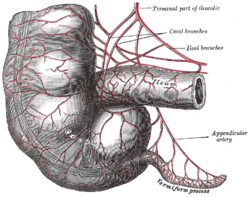虫垂
See also: 蟲垂
Japanese

虫垂 (chūsui): an illustration from Gray's Anatomy, showing the appendix as the worm-shaped portion at lower right, labeled “vermiform process”.
| Kanji in this term | |
|---|---|
| 虫 | 垂 |
| ちゅう Grade: 1 |
すい Grade: 6 |
| kan’on | |
Etymology
Appears to be a coinage in Japanese as a compound of 虫 (chū, “worm”) + 垂 (sui, “appendix (anatomy)”), replacing earlier 虫様突起 (chūyō tokki, “vermiform process”).[1]
It seems that the 突起 (tokki, “protrusion; protuberance; process”) portion in the older term was first replaced with 垂 (sui, “dangling; hanging (from something); appendix”) as 虫様垂 (chūyō sui, literally “worm-shaped dangling → vermiform appendix”), which in turn was shortened to modern 虫垂 (chūsui).
Compare Dutch wormvormig aanhangsel, English vermiform appendix.
Pronunciation
Noun
虫垂 (hiragana ちゅうすい, rōmaji chūsui)
- (anatomy) an appendix, a vermiform appendix
- Synonyms: 虫様垂 (chūyō sui) (rare), 虫様突起 (chūyō tokki) (dated), 盲腸 (mōchō) (informal)
Usage notes
In informal usage, the term 盲腸 (mōchō) is more common. In medical contexts, 虫垂 (chūsui) is preferred, as 盲腸 (mōchō) refers more specifically to the caecum instead of the appendix.
Derived terms
- 虫垂炎 (chūsuien): appendicitis
This article is issued from
Wiktionary.
The text is licensed under Creative
Commons - Attribution - Sharealike.
Additional terms may apply for the media files.